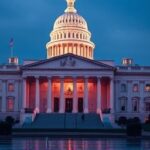The U.S. economy may have suffered a staggering $14 billion blow from the recent monthlong Government shutdown, according to a stark warning from the Congressional Budget Office (CBO). This estimate, detailed in the CBO’s latest analysis, underscores the fragility of federal operations and their far-reaching impact on national growth. As lawmakers grapple with partisan divides over the federal budget, economists are sounding alarms that the true toll could climb even higher, factoring in delayed investments and shaken consumer confidence.
- CBO’s Detailed Breakdown of Shutdown-Induced Economic Losses
- Federal Workers Bear the Brunt as Shutdown Drains Household Incomes
- Business Sectors Reel from Federal Budget Delays and Contract Freezes
- Economists Forecast Broader Ramifications for Long-Term Economic Output
- Path Forward: Urging Bipartisan Fixes to Avert Future Shutdown Crises
CBO’s Detailed Breakdown of Shutdown-Induced Economic Losses
The Congressional Budget Office’s report paints a vivid picture of how the Government shutdown disrupted economic output across multiple sectors. At its core, the CBO calculates that the 35-day impasse led to a direct loss of approximately $11 billion in economic activity during the shutdown period itself. However, when accounting for lingering effects like postponed federal contracts and reduced government spending, the total figure balloons to $14 billion. This projection is based on models that simulate the shutdown’s drag on gross domestic product (GDP), highlighting a 0.3% to 0.6% dip in quarterly growth.
Key to the CBO’s methodology is the assessment of federal budget disruptions. Non-essential government services ground to a halt, furloughing over 800,000 federal employees and affecting millions more through indirect channels. ‘The shutdown represents a self-inflicted wound on the economy,’ CBO Director Phillip Swagel stated in the report’s foreword. ‘Our estimates conservative as they are, reveal the high cost of fiscal uncertainty.’
To illustrate the scale, consider the federal budget’s role in everyday economic output. Agencies like the Department of Defense and the IRS saw operations curtailed, delaying payments to contractors and stalling tax refunds. The CBO notes that every day of shutdown equated to roughly $400 million in lost output, a figure derived from historical data on previous impasses. This isn’t just numbers on a page; it’s real-world consequences for businesses waiting on government approvals and families relying on federal aid programs.
Federal Workers Bear the Brunt as Shutdown Drains Household Incomes
While the macro-economic loss grabs headlines, the human element of the Government shutdown cannot be overlooked. Hundreds of thousands of federal workers faced unpaid leave, with many dipping into savings or turning to food banks to make ends meet. The CBO report quantifies this strain, estimating that household incomes dropped by an average of $2,000 per affected worker during the shutdown. This immediate hit to personal finances rippled outward, curbing consumer spending—a pillar of U.S. economic output.
Take, for instance, the stories emerging from Washington, D.C., and other federal hubs. TSA agents, park rangers, and IRS staff worked without pay, only to receive back wages weeks later. But the delay meant deferred bills and heightened financial stress. ‘For many, this shutdown was more than an inconvenience; it was a crisis,’ said Heather Boushey, an economist at the Washington Center for Equitable Growth. In interviews with affected employees, common themes emerged: canceled vacations, strained mortgages, and anxiety over future stability.
The federal budget’s contingency funds proved insufficient to buffer these impacts fully. While essential workers continued paid duties, the furlough of non-essential staff created bottlenecks. The CBO highlights that small businesses dependent on federal grants—such as those in research and development—faced cash flow crises, leading to layoffs and stalled projects. One ul of stark examples includes the National Institutes of Health, where clinical trials paused, potentially delaying medical breakthroughs and costing the biotech sector millions in lost productivity.
- Furloughed Employees: Over 800,000, with back pay eventually approved but delays causing widespread hardship.
- Working Without Pay: About 420,000 essential personnel, including air traffic controllers, who risked burnout and errors.
- Contractor Impacts: Billions in delayed payments, affecting 1.5 million private-sector jobs tied to federal work.
Economists warn that this loss in economic output from reduced household spending could compound, as families rebuild savings rather than boost retail or travel sectors. The shutdown’s shadow lingers, with consumer confidence indices dropping 5 points in the month following its end, per University of Michigan surveys.
Business Sectors Reel from Federal Budget Delays and Contract Freezes
Beyond individual hardships, the government shutdown’s tentacles reached deep into the business world, freezing federal budget allocations and halting contracts worth billions. The CBO’s analysis reveals that industries reliant on government procurement—defense, construction, and technology—absorbed the lion’s share of the $14 billion loss. For example, the Pentagon’s suspension of non-critical spending idled shipbuilders and software firms, with one Virginia-based contractor reporting a $50 million backlog in unpaid invoices.
The ripple effects on economic output were profound. Small and medium enterprises, often the backbone of local economies, suffered most acutely. A survey by the National Federation of Independent Business found that 40% of members delayed hiring or expansion due to shutdown uncertainties. ‘This wasn’t just a pause; it was a chokehold on innovation and growth,’ noted Mark Zandi, chief economist at Moody’s Analytics, in a recent op-ed.
Consider the agriculture sector, where USDA inspectors were sidelined, leading to export delays for perishable goods. Farmers in the Midwest lost an estimated $300 million in overseas sales, per industry reports. Similarly, the Small Business Administration’s loan processing halted, denying entrepreneurs access to capital at a critical juncture. The CBO projects these disruptions shaved 0.2% off manufacturing output alone, exacerbating vulnerabilities in an already volatile global trade environment.
- Defense Industry: $3.5 billion in deferred contracts, impacting jobs in 45 states.
- Healthcare and Research: Paused FDA approvals and NIH grants, delaying drug development timelines by months.
- Travel and Tourism: Closed national parks cost $1.2 billion in visitor spending, hitting local hotels and guides.
The federal budget’s role as an economic stabilizer was undermined, with sequestration-like effects amplifying the shutdown’s damage. As businesses recalibrate, supply chain snarls persist, potentially inflating costs and eroding competitive edges against international rivals.
Economists Forecast Broader Ramifications for Long-Term Economic Output
While the CBO’s $14 billion figure captures immediate losses, experts caution that the government shutdown’s full economic toll may unfold over years. Lingering uncertainties around the federal budget have investors wary, with stock market volatility spiking 15% during the impasse. The report suggests that if shutdowns become routine, they could erode up to 1% of annual GDP growth, a scenario that would compound the current loss into trillions over a decade.
Broader implications include strained international relations and credit rating pressures. Moody’s downgraded its outlook on U.S. sovereign debt amid the chaos, citing repeated fiscal brinkmanship. ‘The shutdown isn’t isolated; it’s symptomatic of deeper federal budget dysfunction,’ warned Federal Reserve Chair Jerome Powell in congressional testimony. Inflationary pressures could also rise if delayed infrastructure spending triggers catch-up booms, complicating the Fed’s monetary policy.
From a workforce perspective, the psychological toll on federal employees may lead to higher turnover and recruitment challenges. A Government Accountability Office study post-shutdown found a 10% uptick in early retirements among civil servants, depleting institutional knowledge. For the economy at large, reduced federal R&D funding—slashed by $2 billion during the period—threatens innovation pipelines in AI, renewable energy, and biotech.
Comparisons to past events bolster these forecasts. The 2013 shutdown, lasting 16 days, cost $24 billion per CBO estimates adjusted for inflation—a per-day hit higher than the recent one due to deeper sequestration cuts. Yet, the 2018-2019 event’s length amplified absolute losses, setting a worrisome precedent. Economists like those at the Brookings Institution argue that without bipartisan federal budget reforms, future impasses could trigger recessions, especially in a post-pandemic recovery phase.
Path Forward: Urging Bipartisan Fixes to Avert Future Shutdown Crises
As the dust settles on this government shutdown, attention turns to preventing repeats that erode economic output and public trust. Lawmakers on both sides of the aisle have introduced bills to reform the federal budget process, including automatic continuing resolutions to avoid shutdowns over funding disputes. House Speaker Nancy Pelosi emphasized in a recent press conference, ‘We cannot let partisan gamesmanship cost the American people another dime.’
The CBO recommends establishing a bipartisan commission to overhaul appropriations timelines, potentially saving billions in avoided losses. Meanwhile, advocacy groups like the U.S. Chamber of Commerce are lobbying for pay guarantees during future impasses, to mitigate impacts on workers and businesses. On the horizon, upcoming debt ceiling debates in 2023 loom large, with analysts predicting another potential flashpoint unless compromises are reached.
Looking ahead, restoring confidence in federal institutions will be key to rebounding economic output. Investments in digital infrastructure for streamlined budgeting could reduce vulnerabilities, while diversified funding mechanisms might insulate critical sectors. As the nation eyes recovery, the $14 billion lesson from this shutdown serves as a clarion call: fiscal stability is not optional, but essential for sustained prosperity. With mid-term elections approaching, voters will demand accountability, pressuring Congress to prioritize the federal budget’s role in fostering, rather than hindering, growth.









